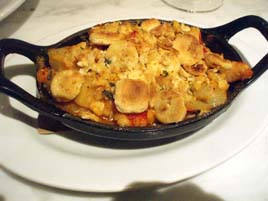Ed's Chowder House
 Friday, September 18, 2009 at 09:50AM
Friday, September 18, 2009 at 09:50AM 
Note: Click here for a more recent review of Ed’s Chowder House.
A new Jeffrey Chodorow restaurant is a bit like a NASCAR race. You suspect there will be a crash. The only question is when?
You have to at least admire Chodorow’s tenacity. After failures at Mix, Rocco’s, Brasserio Caviar & Banana, Tuscan, Tuscan Steak, English is Italian, Wild Salmon, Kobe Club, and Ono, it’s amazing he has any capital left over. Or patience.
When Chodorow opened Center Cut across from Lincoln Center last year, I thought: “Here, finally, is a restaurant he can’t screw up.” Steakhouses seldom fail in New York, and this is a neighborhood that cries out for more dining options. The Lincoln Center restaurants are packed almost every night, despite the fact that very few of them are great. The area needed a place like Center Cut.
I actually liked Center Cut. I didn’t love it, but it was convenient before a show. It was also a place you could get into, and therein lay the problem. Even in a neighborhood that needed more restaurants, the crowds didn’t warm up to Center Cut: I gave plenty of reasons in my review. Once again, Chodorow had screwed up, as only he can.
 Now comes Ed’s Chowder House, built on the carcass that was Center Cut. Chodorow has wisely enlisted Ed Brown of the Michelin-starred eighty one, who knows a thing or two about seafood from his thirteen-year stint at Rockefeller Center’s Sea Grill.
Now comes Ed’s Chowder House, built on the carcass that was Center Cut. Chodorow has wisely enlisted Ed Brown of the Michelin-starred eighty one, who knows a thing or two about seafood from his thirteen-year stint at Rockefeller Center’s Sea Grill.
This isn’t a gut renovation—Center Cut’s wine wall still separates the bar and the dining room—but the space is now much brighter and livelier. It’s tough to compare a steakhouse and a seafood shack, but prices here are much lower. Center Cut had $17 cocktails (one of Chodorow’s many errors), but they top out here at $12. There are acceptable wines below $50, which Center Cut didn’t have.
The front area, where I ate, is called the “Chowder Bar.” It has its own menu that partly overlaps the dining room menu, but has a few of its own items—a burger ($15) and a lobster roll ($24), for instance. But the servers there offer you the dining room menu too, which leaves you with a lot to ponder.
Too much, in fact. This is the failing of every Chodorow restaurant I’ve visited. At Wild Salmon, even a physicist couldn’t have calculated the number of variations. Chodorow is positively restrained here, but there are still twenty-five entrées in two categories ($17–35)—half of them in a boxed-off list captioned “simply,” the other half being composed plates.
I would far prefer to see the list of the entrées that the restaurant can do really well—and I guarantee you it’s not all twenty-five of them.
The appetizer list is a bit more sensible, with ten choices ($9–16), but there are four soups ($9–15), nine sides ($6), and the obligatory raw bar. Both menus (dining room and chowder bar) have dates printed on them, which suggests they’ll be revised frequently.


Center Cut had a terrific bread service, and so does Ed’s Chowder House (above left). Among the soups are three kinds of chowder, or you can get a sampler for $12 (above right). I loved the New England clam chowder and the sweet corn chowder, but the Manhattan-style chowder tasted like Campbell’s.


A Savory Lobster Crumble ($16; above left) is listed as an appetizer, but it’s hearty enough to be a small entrée. I would be happy to eat this again. I asked a server to recommend her favorite side dish, and she suggested the Jalapeño Creamed Corn (above right), and this was also very good.
This was the first night for Ed’s Chowder House, so consider this a preliminary view. The Chod himself was in the house. Servers were more polished than I would expect at a brand new restaurant. A cocktail took a bit too long to appear, but the staff got me out in time for my 7:30 concert. There was no attempt to upsell me—a first in a Chodorow restaurant.
If this were really Ed Brown’s Chowder House, I would confidently predict success. But this is also Jeffrey Chodorow’s House, and he’s proved there’s no restaurant he can’t foul up. I’ll be rooting for this one, not for any partisan reason, but simply because it’s always good to have another option at Lincoln Center.
Ed’s Chowder House will get a repeat visit from me. I can only hope that after Ed Brown decamps uptown, the China Grill Management folks don’t screw it up.
Ed’s Chowder House (44 W. 63rd St. btwn. Broadway & Columbus, Lincoln Center)
























